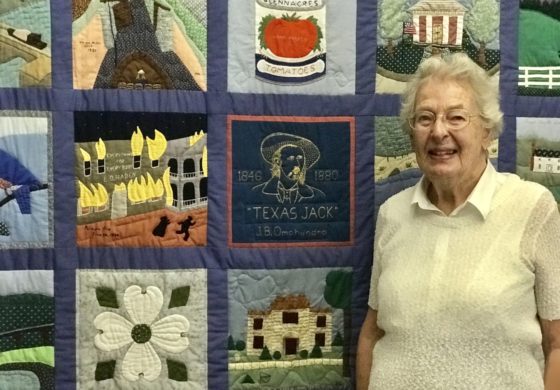By Ruthann Carr
Correspondent
A newly retired chemistry professor moved with her husband to Lake Monticello in 1988.
While Nel Stofberg wasn’t a stranger to knitting and sewing, she wasn’t familiar with the art of quilting until she moved to the Lake.
She joined a group who call themselves the Piecemakers. Quilts are made of sections of fabric sewn, or pieced, together.
“I wanted to try something new,” Stofberg said. “I love it. The results you have, that you made yourself. When you’re all finished you think, ‘That’s something I created.’”
Ellen Miyagawa moved with her husband to Fluvanna 10 years prior to Stofberg.
Miyagawa immersed herself in learning Fluvanna history and became a familiar name associated with the Fluvanna Historical Society. She was also well known as an artist. The Historical Society sells a book of Miyagawa’s pen and ink drawings of historic Fluvanna buildings.
Some may not know Miyagawa was also an avid quilter. She and Stofberg became quilting buddies.
“Ellen Miyagawa saw a historical quilt, I think it might have been in Orange, and she said, ‘Shall we make a historical quilt for Fluvanna?’” Stofberg said.
Without a pattern, they took on the task of creating and stitching together a quilt that told the story of Fluvanna.
The quilt took nearly two years to complete, with Stofberg, Miyagawa and 10 other piecemakers working on the masterpiece that now hangs in the Old Stone Jail Museum in the Village of Palmyra.
Weeks ago, museum volunteer Carolyn Talley took the quilt down to be cleaned and realized it had been 25 years since the quilters presented it to the historical society.
“There is one square that lists the names of all the quilters who worked on it and the date it was presented,” Talley said. “I wondered if any of the quilters were still around.”
Miyagawa died in 2006.
The only quilter she could get in touch with was Stofberg.
Stofberg was pleased to learn the quilt is not only admired by visitors, but also used by Talley and other volunteers to teach student groups about Fluvanna history.
“I sit the children down in front of the quilt and point to different squares and ask if they know what it represents,” Talley said.
There are 30 squares, many showing aspects of life in Fluvanna. Some illustrate industries such as farming, navigation and tobacco. One of the squares is a can of Glennacres tomatoes representing the canning industry that thrived in Fluvanna from the 1920s until after World War II.
Stofberg created eight of the squares, including the one depicting the June 1930 fire that destroyed most of the Village of Palmyra.
Other squares are dedicated to John Baker “Texas Jack” Omohundro, the gateway to Fork Union Military Academy, the Old Stone Jail, Civil War Park and the covered bridge that first spanned the Rivanna River in 1884.
Stofberg said she was recently looking through her fabric for a yellow piece.
“I found a yellow fabric that was all jagged and wondered, what did I use this for,” she said. “Then I realized it was the same fabric I used to cut out the flames for the fire.”
She said when Talley told her she had the quilt cleaned she wondered if some of the appliques may have frayed.
“It’s easy to stitch a straight line of fabric, but to stitch around points is really hard,” Stofberg said.
She was thrilled to see the quilt came back unscathed. “It was clean and absolutely undamaged,” she said.
The names of the quilters stitched into the final panel are: Ellen Miyagawa, Nel Stofberg, Irene Jaworowski, Sally Gaither, Millie Martin, Dot Salter, Kathryn Rison, Sue Reeder, Emma Fry, Sarah Stone and Florence Leslie. Ruby Schumaker did not make a square, but stitched the Glennacre Tomato can because it represented her family’s business.
Anyone interested in seeing the quilt can attend the Historical Society’s next Second Sunday on July 14 at 2 p.m. in the Village of Palmyra.





